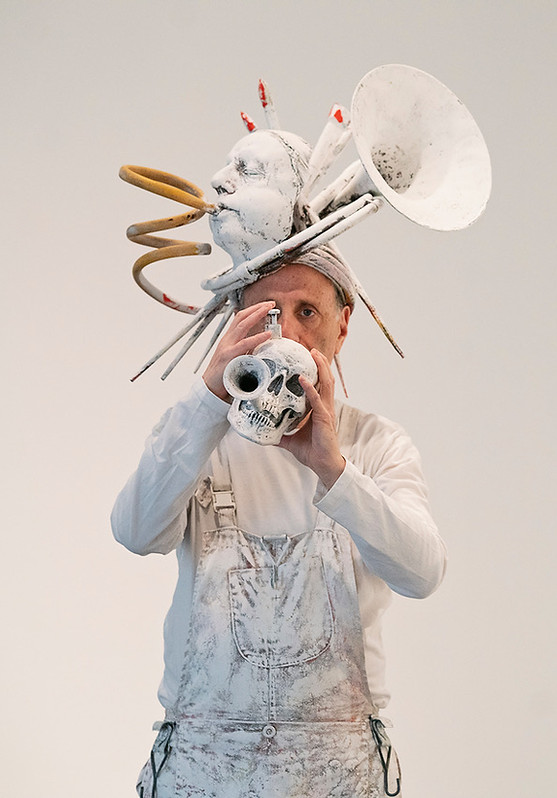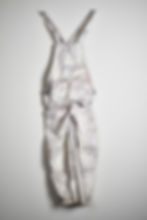Philip Haas

Sculpture Breathes Life Into Painting & Music
At once an installation and a performance, Sculpture Breathes Life into Painting & Music consists of more than thirty
individual objects, making a single unified work of art. The materials used include marble, bronze, plaster, resin, wood, metal, rubber,
leather, linen, glass eye, bone, garden hose, battery-powered radio, iPad, oil painting, and, indeed, the artist himself, wearing a sculptor's table.
There are multiple self-portraits as well as depictions of artists, presented in sculpture and film, from antiquity to the recent past, including Eustache Le Sueur imprisoned in his muse's viola da gamba; the hands of Jacques Villon holding his brushes excised from a photographic portrait by Brassaï; the feet of Jacques-André Boiffard and a woman in flagrante delicto; Meret Oppenheim as a drunken centaur; endless Magrittes emerging from a picture frame; Van Gogh evoked by his iconic chair; the composer Anton Rubinstein embedded in a Sabazius cult hand; Annibale Carracci in his butcher's shop; James Ensor serenaded by clowns at Carnival; Giovanni Battista Tiepolo, Prospero-like, surveying his domain of nearly one hundred mythological and allegorical figures; the Arhat monk taming a dragon; and Douris severing the head of Pentheus.


Additional works in the exhibition range in inspiration from anonymous photographs of a North African nude and a house damaged in the Johnstown Flood to Velasquez's portrait of a dwarf to Leda and the swan of classical mythology.
Haas has invented multiple instruments for the installation, including a lyre made from his sculpted head, a trumpet skull, a serpent-shaped horn featuring a dragon's head, and a hybrid-string upright incorporating a radio.

The accompanying soundscape uses samples recorded from the instruments as well as the singing of the sirens of Greek antiquity recreated by local singers on the island of Procida in the Bay of Naples.
For an example of the soundscape please click below:
The artist remarks in his spoken text, “My sculptural style corresponds to my physiognomy, my appearance; I have a light complexion and blue eyes; this coloring is naturally reflected in my work...the light style...is connected to my fanciful and disturbed temperament. There is no past or future in art. If a work of sculpture cannot live always in the present, it must not be considered at all. All visual art tends toward sculpture.
Painting is sculpture in two dimensions. Film is sculpting with light. Sculpture gives birth to music. Sculpture is my breath. I am suffering from sculpture fever.”


The propelling impulse behind his work comes from a Surrealist aesthetic, one where fragmentary views of a given image can be read as visual quotations or where unexpected juxtapositions create an entirely new reality. His sculptures are so faithfully rendered and skillfully executed that the spectator is momentarily transported to an alternate realm of existence, one that hovers mysteriously somewhere between illusion and reality. Viewers are invited to contemplate the links between the objects, thereby allowing them to write their own stories and establish separate, but not necessarily incompatible, interpretations of the ensemble.


Spoken Text
I am suffering from sculpture fever.
Sculptors take the same liberties as poets, clowns and lunatics.
Sculpture is not a science.
It causes its practitioner to sweat and endure great fatigue.
The artist’s body becomes powdered and plastered with white dust and clay,
which makes him look like a baker.
His house is a shambles and covered in residue and fragments of statuary.
John Ruskin, the aesthete, remarks that Alexander Munro, like all sculptors, lives in a nasty wood house, full of water tubs and detritus, so he cannot visit without catching a cold.
This same Ruskin, accustomed only to the smoothness of classical nude statues, is horrified by the wedding-night revelation that his bride has pubic hair.
Apollodoros of Damascus is called a madman because he is a severe critic of his own work and often shatters a finished marble, at a loss to reach the ideal at which he aims.
Jacob Cornelisz, who Italians call Cope', spends his entire life working on a single sculpture, unable to keep his hands off it, never letting anyone see. He is solitary, suspicious and melancholic, trusting nobody. He sculpts himself to death.
How different the painter and composer's situation;
they are well dressed, arrayed in the clothes they fancy, their homes clean.
At the turn of the fourth century before Christ, Parrhasius of Ephesus signs his paintings:
“One who lives in luxury.”
Working in clay, wood, marble and bronze is not for a gentleman.
Sculpture may need a wall, but, unlike a painting, never a roof.
Benvenuto Cellini explains the art of sculpture is eight times as great as any other art, because a statue has eight views, and they all must be equally good. Painting is seen from only one side.
The difference between painting and sculpture is as pronounced as between a shadow and
the object casting it. The sculptor is an orator, the painter a grammarian,
and the composer, somewhere in between.
Sculpture is the mother of all arts.
I see René Magritte in the marble and carve until I set him free.
Sometimes a portrait tries to look like its model, but, says Magritte, one might wish that the model tries to look like her portrait.
John Singer Sargent says:
“A portrait is a likeness in which there was something wrong about the mouth.”
Portraiture is an attitude.
What is more surreal than a nose between two eyes?
Salvador Dalí announces:
"With the surrealist object I kill modern painting."
Joan Miro adds:
“I want to assassinate painting.”
The actor David Garrick puts his head through the gap between the two leaves of a door, and, in the space of four or five seconds, his face passes successively from wild joy to moderate joy, from joy to composure, from composure to surprise, from surprise to astonishment, from astonishment to sadness, from sadness to gloom, from gloom to fright, from fright to horror, from horror to despair, and then back again from this final stage up to the one he started from.
Thomas Gainsborough, the painter, complains:
“Garrick has everyone’s face but his own.”
The sculptor must transform himself totally into an actor, often in front of a mirror
where he is, at once, the performer and beholder.
But here a poetic spirit is necessary in order to imagine oneself in another person's place.
I think I shall know how to be original even when imitating. Who is there among great men and women, who has not imitated? Nothing is made of nothing.
We are all the sons and daughters of Homer.
"Sing in me muse, and through me tell..."
Sculpture is my breath.
Sometimes it is necessary for a sculptor to shut his eyes in order to see.
Constantin Brancusi says:
"New York is my studio on a large scale. True architecture is sculpture.”
When Marcel Duchamp arrives in New York, he thinks plumbing and bridges
are the greatest works of American sculpture.
Sculpture gives birth to music.
The best way to write music: study Duchamp.
"Sculpture is the art of the hole and the lump," says Auguste Rodin.
The yearning for a woman stimulates the imagination and creativity of the sculptor
more than the fulfilment of his desires.
Pablo Picasso claims:
"Sculpture is the best comment that a painter can make on painting.”
Vincent Van Gogh, the Dutchman, says:
“I’d rather have 150 francs a month as an artist,
than 1,500 francs a month as anything else, even as an art dealer.”
As for Paul Gaugin, his art goes way back, further than antiquity, further than the horses on the Parthenon, all the way back to the dear old horsy of his childhood.
My sculptural style corresponds to my physiognomy, my appearance. There are more than a few points where the physiology of men of genius meets with the pathology of the insane.
I am all the sculptures I have encountered; all the women I have embraced.
There is no past or future in art.
If a work of sculpture cannot live always in the present, it must not be considered at all.
Remove the monumental statues out of the museums, out of their slumber,
and put them where they belong, in crowded neighborhoods.
Film is sculpting with light.
Auguste and Louis Lumière, the pioneers, assure us:
"Cinema is an invention without a future.
Sculpture derives from sculpture.
Alberto Giacometti says:
“Since the subject in a self-portrait is always available, you just go on and on.”
Desiring greater richness in his sculptures' expressions,
Donatello turns towards them, and mutters under his breath:
"Speak, damn you, speak!"
Samuel Johnson says:
“It matters not how a man dies, but how he lives.”
Lytton Strachey asks:
“What has posterity ever done for me?”
As I get older, I drive myself harder. I become more obsessed with my work, more ambitious.
Horace writes:
“You don’t know how many winters Zeus has given you. This could be the last.”
I am in the world only for the purpose of sculpting.
What I sculpt is life. I don’t sculpt to live, I live to sculpt.
If you don't have a friend who's a sculptor, you're in trouble.
Let there be sculpture!